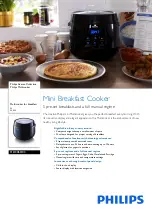
8
Because of the unique design of your electriQ vortex system dehydrator, you will be surprised at how quick is
the drying process.
Drying Times
Drying times indicated in this user instructions are for reference only and they may vary a lot, depending on
the type and amount of food, thickness and evenness of the slices, percentage of water in the food, humidity,
temperature of air, altitude. Drying times may also vary greatly from one area to another and from day to day,
depending on the climatic conditions. Keep records to help you predict drying times for specific foods.
Drying Temperature
Fruits, fruit rolls (fruit leather) and vegetables should be dried at 40 - 60
℃
. By drying foods in this
temperature range you will minimize the loss of heat-sensitive vitamins A and C. All foods sweat when they
begin to dry, the temperature may be set higher at 60
℃
or 70
℃
during the first couple of hours of drying. The
actual temperature of the food will remain to around 5o to 6o
℃
, lower than the air temperature for the first
couple of hours.
Meats and fish should be dried on the highest temperature setting of your dehydrator at 70
℃
. These
temperatures also keep bacteria and other spoilage micro-organisms, common to meat and fish, to a
minimum during the first stages of drying.
Nuts and seeds are high in oil, and if higher temperatures are used, they will tend to become rancid,
developing unpleasant flavours. The best temperature is from 35 to 50
℃
.
Herbs and spices are most flavourful when they first open and should be harvested while very fresh, before
they begin to blossom. Because the aromatic oils are very sensitive, temperature should be set to 35
℃
.
Flowers, herbs and spices used for potpourri should be dried at 35
℃
to maintain aroma and colour.
Take care not to load trays too heavily as this will prolong the drying time.
Packaging
Some pieces may dry in a shorter time than others. The dried food should be removed and placed in an
airtight container while allowing the rest of the pieces to remain in the dehydrator until sufficiently dry.
Package all dried foods promptly to prevent contamination and to prevent stickiness and re-hydration caused
by humidity. Store dried foods in airtight, moisture proof containers.
Home vacuum packaging devices are ideal for packaging dried foods as eliminating the air will extend the
shelf life of dried foods 3 to 4 times.
Since most packaging materials are transparent, store packaged dried foods in a plastic or metal container
that will not allow the light to penetrate. Do not store fruits and vegetables together in the same storage
container because flavour and moisture may transfer.









































